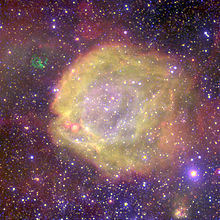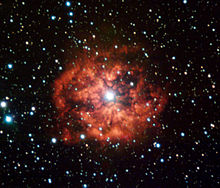- Wolf–Rayet star
-
Wolf–Rayet stars (often referred to as WR stars) are evolved, massive stars (over 20 solar masses initially), which are losing mass rapidly by means of a very strong stellar wind, with speeds up to 2000 km/s. While our own Sun loses approximately 10−14 solar masses every year, Wolf–Rayet stars typically lose 10−5 solar masses a year.[1]
Wolf–Rayet stars are very hot, with surface temperatures in the range of 25,000 K to 50,000 K.
Contents
Observation history
In 1867, astronomers using the 40 cm Foucault telescope at the Paris Observatory discovered three stars in the constellation Cygnus (now designated HD191765, HD192103 and HD192641) that displayed broad emission bands on an otherwise continuous spectrum.[2] The astronomers' names were Charles Wolf and Georges Rayet, and thus this category of stars became named Wolf–Rayet (WR) stars.[3] Most stars display absorption bands in the spectrum, as a result of overlying elements absorbing light energy at specific frequencies. The number of stars with emission lines is quite low, so these were clearly unusual objects.
The nature of the emission bands in the spectra of a Wolf–Rayet star remained a mystery for several decades. Edward C. Pickering theorized that the lines were caused by an unusual state of hydrogen, and it was found that this "Pickering series" of lines followed a pattern similar to the Balmer series, when half-integral quantum numbers were substituted. It was later shown that the lines resulted from the presence of helium; a gas that was discovered in 1868.[4]
By 1929, the width of the emission bands was being attributed to Doppler broadening, and hence that the gas surrounding these stars must be moving with velocities of 300–2400 km/s along the line of sight. The conclusion was that a Wolf–Rayet star is continually ejecting gas into space, producing an expanding envelope of nebulous gas. The force ejecting the gas at the high velocities observed is radiation pressure.[5]
In addition to helium, emission lines of carbon, oxygen and nitrogen were identified in the spectra of Wolf–Rayet stars.[6] In 1938, the International Astronomical Union classified the spectra of Wolf–Rayet stars into types WN and WC, depending on whether the spectrum was dominated by lines of nitrogen or carbon-oxygen respectively.[7]
Description
 AB7 is one of the highest excitation nebulae in the Magellanic Clouds, two satellite galaxies of our own Milky Way
AB7 is one of the highest excitation nebulae in the Magellanic Clouds, two satellite galaxies of our own Milky Way
Wolf–Rayet stars are a normal stage in the evolution of very massive stars, in which strong, broad emission lines of helium and nitrogen ("WN" sequence) or helium, carbon, and oxygen ("WC" sequence) are visible. Due to their strong emission lines they can be identified in nearby galaxies. About 300 Wolf–Rayets are catalogued in our own Milky Way Galaxy.[8][9] This number has changed during the last years as the result of very deep photometric and spectroscopic surveys dedicated to discovering this kind of object in the Galactic plane.[10][11][12] Additionally, about 100 are known in the Large Magellanic Cloud, while only 12 have been identified in the Small Magellanic Cloud, and a few more in galaxies in the Local Group, and nearby galaxies (M83, NGC300, etc.).
Several astronomers, among them Rublev (1965)[13] and Conti (1976)[14] originally proposed that the WR stars as a class are descended from massive O-stars in which the strong stellar winds characteristic of extremely luminous stars have ejected the unprocessed outer H-rich layers.
The characteristic emission lines are formed in the extended and dense high-velocity wind region enveloping the very hot stellar photosphere, which produces a flood of UV radiation that causes fluorescence in the line-forming wind region. This ejection process uncovers in succession, first the nitrogen-rich products of CNO cycle burning of hydrogen (WN stars), and later the carbon-rich layer due to He burning (WC and WO stars). Most of these stars are believed finally to progress to become supernovae of Type Ib or Type Ic. A few (roughly 10%) of the central stars of planetary nebulae are, despite their much lower (typically ~0.6 solar) masses, also observationally of the WR-type; i.e., they show emission line spectra with broad lines from helium, carbon and oxygen. Denoted [WR], they are much older objects descended from evolved low-mass stars and are closely related to white dwarfs, rather than to the very young, very massive stars that comprise the bulk of the WR class.[15]
Evolution models
Evolution models[clarification needed] of WR stars.[15]
For stars of ~40-75 MS
- O → LBV → WN(H-poor) → WC → SN Ic
For stars of 25-40 MS
- O → LBV → WN(H-poor) → SN Ib
OR
- O → RSG → WN(H-poor) → SN Ib
It is possible for a Wolf–Rayet star to progress to a "collapsar" stage in its death throes: This is when the core of the star collapses to form a black hole, pulling in the surrounding material. This is thought to be the precursor of a long gamma-ray burst.
The best known (and most visible) example of a Wolf–Rayet star is Gamma 2 Velorum (γ² Vel), which is a bright star visible to those located south of 40 degrees northern latitude. One of the members of the star system (Gamma Velorum is actually at least six stars) is a Wolf–Rayet star. Due to the exotic nature of its spectrum (bright emission lines in lieu of dark absorption lines) it is dubbed the "Spectral Gem of the Southern Skies".[16]
See also
- Gamma-ray burst
- Hypernova
- Starburst galaxy
- Wolf–Rayet nebula
- WR 104
References
- ^ Cannizzo, J. K. (June 3, 1998). "Ask an Astrophysicist: Wolf-Rayet Stars". Nasa.gov. http://imagine.gsfc.nasa.gov/docs/ask_astro/answers/980603a.html.
- ^ Huggins, William; Huggins, Mrs. (1890-1). "On Wolf and Rayet's Bright-Line Stars in Cygnus". Proceedings of the Royal Society of London 49 (296-301): 33–46. Bibcode 1890RSPS...49...33H. doi:10.1098/rspl.1890.0063.
- ^ Murdin, P. (2001). Wolf, Charles J E (1827-1918). Bristol: Institute of Physics Publishing. doi:10.1888/0333750888/4101.
- ^ Fowler, A. (1912). "Hydrogen, Spectrum of, Observations of the principal and other series of lines in the". Monthly Notices of the Royal Astronomical Society 73: 62–105. Bibcode 1912MNRAS..73...62F.
- ^ Beals, C. S. (1929). "On the nature of Wolf-Rayet emission". Monthly Notices of the Royal Astronomical Society 90: 202–212. Bibcode 1929MNRAS..90..202B.
- ^ Beals, C. S. (1933). "Classification and temperatures of Wolf-Rayet stars". The Observatory 56: 196–197. Bibcode 1933Obs....56..196B.
- ^ Swings, P. (1942). "The Spectra of Wolf-Rayet Stars and Related Objects". Astrophysical Journal 95: 112–133. Bibcode 1942ApJ....95..112S. doi:10.1086/144379.
- ^ van der Hucht, K. A. (2001). "The VIIth catalogue of galactic Wolf–Rayet stars". New Astronomy Reviews 45 (3): 135–232. Bibcode 2001NewAR..45..135V. doi:10.1016/S1387-6473(00)00112-3.
- ^ van der Hucht, K. A. (2006). "New Galactic Wolf-Rayet stars, and candidates". Astronomy and Astrophysics 458 (2): 453–459. arXiv:astro-ph/0609008. Bibcode 2006A&A...458..453V. doi:10.1051/0004-6361:20065819.
- ^ Shara, M. M.; et al., Anthony F. J.; Gerke, Jill; Zurek, David; Stanonik, Kathryn; Doyon, René; Artigau, Etienne; Drissen, Laurent et al. (2009). "A Near-Infrared Survey of the Inner Galactic Plane for Wolf-Rayet Stars. I. Methods and First Results: 41 New WR Stars". Astronomical Journal 138 (2): 402. Bibcode 2009AJ....138..402S. doi:10.1088/0004-6256/138/2/402.
- ^ Mauerhan, J. C.; et al., Schuyler D.; Morris, Pat W. (2009). "12 New Galactic Wolf-Rayet Stars Identified via 2MASS + Spitzer/GLIMPSE". Publication of the Astron. Soc. of the Pacific 121 (880): 591–605. Bibcode 2009PASP..121..591M. doi:10.1086/603544.
- ^ Hadfield, L. J.; et al., S. D.; Morris, P. W.; Smith, J. D.; Marston, A. P.; Peterson, D. E. (2007). "Searching for hidden Wolf–Rayet stars in the Galactic plane – 15 new Wolf–Rayet stars". Monthly Notices of the Royal Astron. Soc. 376 (1): 248–262. arXiv:astro-ph/0612574. Bibcode 2007MNRAS.376..248H. doi:10.1111/j.1365-2966.2007.11424.x.
- ^ Rublev, S. V. (1965). "Dynamic State of the Atmospheres of Wolf-Rayet Stars". Soviet Astronomy 8: 848. Bibcode 1965SvA.....8..848R.
- ^ ,Conti, P. S. (1976). Proc. 20th Colloq Int. Astrophys. Liege.
- ^ a b Crowther, P. A. (2007). "Physical Properties of Wolf-Rayet Stars". Annual Review of Astronomy and Astrophysics 45 (1): 177–219. arXiv:astro-ph/0610356. Bibcode 2007ARA&A..45..177C. doi:10.1146/annurev.astro.45.051806.110615.
- ^ Hoffleit. "The Bright Star Catalogue, 5th Revised Ed.". http://www.alcyone.de/SIT/mainstars/SIT000822.htm#Cat1. Retrieved August 8, 2007.
External links
- physics.usyd.edu.au Some Wolf–Rayet stars in binaries are close enough that we can image a rotating "pinwheel nebula" showing the dust generated by colliding winds in the binary system, from Aperture Masking Interferometry observations.
- harvard.edu Wolf–Rayet Stars: Spectral Classifications
- astro.lsa.umich.edu ApJ 525:L97-L100 Nov. 10, 1999. Monnier, Tuthill & Danchi: Pinwheel Nebula Around WR98a (PDF)
- uk.arxiv.org ApJ Jan. 3,2005. Dougherty, et al.: High Resolution Radio Observations of the Colliding Wind Binary WR140 (PDF)
- harvard.edu A catalog of northern Wolf–Rayet Stars and the Central Stars of Planetary Nebulae (Harvard)
- nytimes.com Scientists See Supernova in Action
- nasa.gov Big Old Stars Don't Die Alone (NASA)
Variable stars Pulsating Cepheids and
cepheid-likeBlue-white with
earlyspectraBeta Cephei · PV TelescopiiOtherEruptive Giants and
supergiantsEruptive binaryCataclysmic
or explosiveRotating Non-sphericalEllipsoidalStellar spotsFK Comae Berenices · BY DraconisMagnetic fieldsEclipsing  The Star Portal
The Star PortalSupernovae Classes Related - Near-Earth supernova
- Supernova impostor
- Hypernova
- Quark-nova
- Pulsar kicks
Structure Progenitors - Luminous blue variable
- Wolf–Rayet star
- Supergiant
- (Blue
- Red
- Yellow)
- Hypergiant
- (Yellow)
- White dwarf
- (Related links)
Remnants Discovery Lists - Notable supernovae
- Supernova remnants
- Candidates
- Massive stars
- In fiction
Notable Research Categories:- Star types
- Wolf-Rayet stars
Wikimedia Foundation. 2010.


